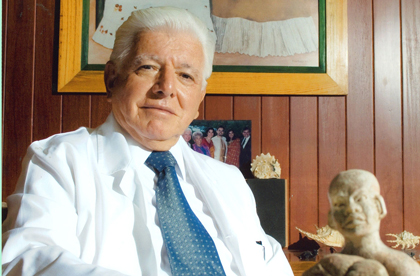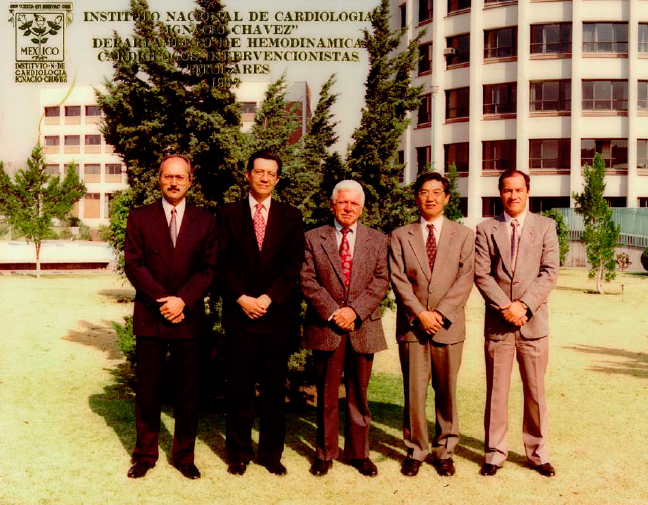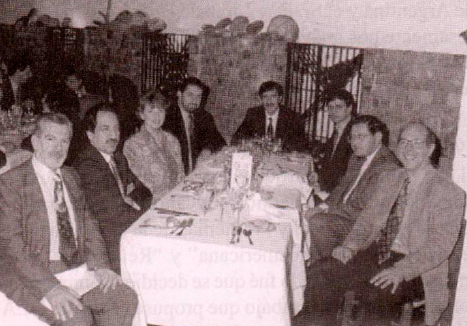
He first knew he would go into Cardiology early in medical school: “As I took the required Cardiology class, my professors took notice of certain characteristics that led them to the belief that I should be a cardiologist. That made a strong impression,” recalls a deeply moved Martínez Ríos.
After finishing his residency in Cardiology at the National Cardiology Institute of Mexico, he was sent to the United States to study cardiac catheterization so that he would learn how to perform coronary arteriographies, which were still quite uncommon in Mexico.
How did you specialize in Interventional Cardiology?
I became specialized gradually, through training programs with Andreas Gruentzig in Zürich, first, and then in Atlanta. Nowadays, there are Interventional Cardiology university programs; back then [in the 1970s], there was nothing of the sort.
Currently, Dr. Marco Antonio Martínez Ríos is Director-General at the Ignacio Chávez National Cardiology Institute; he has held this position since 2009. Former Mexican Health Secretary Mercedes Juan López has publicly declared that in the last five years, during the Martínez Ríos administration at the Institute, operating rooms were modernized, special rooms for hemodynamic procedures were prepared, and outpatient consultations expanded, among other positive changes in various areas.
How was this improvement process at the National Cardiology Institute?
During these past seven and a half years in which I have been Director-General, the Institute has undergone many changes. It has adapted to modern Cardiology. New rooms for catheterization have been prepared; we have acquired a 256-slice dual-source computerized tomography scanner and a new magnetic resonance imaging machine; surgical areas and intensive care units have been remodeled, and patient management processes have been updated in areas such as outpatient consultation, laboratory services, and critical services. In these last years we have managed to implement the latest advancements in the fastest-growing Cardiology areas, such as Interventional Cardiology, Electrophysiology, and Cardiovascular Imaging. Moreover, as regards research, we are home to over 110 high-productivity members of the National Research System [Sistema Nacional de Investigadores]. We train over 350 medical residents per year, who come from the Cardiology Program at the National Autonomous University of Mexico to learn about postgraduate specialties such as Interventional Cardiology, and Cardiology-related specialties such as Nephrology, Cardiac Surgery, Pediatric Cardiology, Rheumatology, etc.

Our institution has successfully produced National Cardiology Institute biological valve prosthesis for the past 30 years. We are currently developing the first National Cardiology Institute stents, with our own technological design, which are currently in being tested in animal studies. The Institute was the first TAVI-certified center in Mexico; we have worked with all available models in the country. We are currently working on a design of our own. As regards Interventional Cardiology, we have gained experience in congenital heart defects, and we are considered an international expert center; through this approach, we treat almost half of all patients diagnosed with these conditions nationwide.
You are a professor at the undergraduate and postgraduate programs at the Autonomous University of Mexico. What is the significance of teaching and training young professionals for you?
Teaching is one of the activities I enjoy the most. Contact with medical school students and training cardiologists is invigorating. I am committed to providing quality training for tomorrow’s Cardiology leaders. Through teaching we remain updated on the basics of our specialty, and sometimes we are faced with questions that encourage us to do research.

In 1989 I was appointed as Chief of the Department of Hemodynamics at the National Cardiology Institute. My goal was very clear: remodeling all catheterization rooms. Five new rooms were prepared and young staff was sent abroad for specialized training. Upon their return, we updated the roster of attending physicians. Filled with strength and motivation, the Department and international professors were invited to create high-level academic programs. On the same vein, international courses were created, which, in turn, sparked the need to create an academic group within the framework of one of these events: the First Interamerican Course on Interventional Cardiology. The most important Latin American specialists were invited to the event and, on the last day of the aforementioned course, the Latin American Group of Interventional Cardiology was officially founded. The Group met at least twice per year, within the framework of the American College of Cardiology (ACC) and the American Heart Association (AHA) Congresses, holding the most excellent academic and social activities.
What is your fondest memory in all these years as a SOLACI member?
My fondest memory is probably the transformation undergone by SOLACI. It has gone from a dream conceived by a few interventional cardiologists to a mature, world-renowned society. As founding members, we never quite fathomed what we were creating. Nowadays, SOLACI is considered an international expert organization. It has adapted to the present in order to achieve its initial goals. I am convinced that this is the bright beginning of an even more productive story that will continue to evolve through the energy of future generations.
And what is your fondest memory as regards congresses?
I have the fondest memories of the 2000 SOLACI Congress in Mexico City, which I presided. The most important Mexican institutions took part in it through the presentation of live cases and the presence of distinguished lecturers. I would like to mention and acknowledge the contribution of the late Dr. Manuel Gil, who was my Secretary and played a crucial role in the successful development of all Congress activities. On top of everything, SOLACI has given me the opportunity to foster close friendships with Latin American colleagues, with whom I have shared the most enjoyable moments.
By Laura Spiner.





